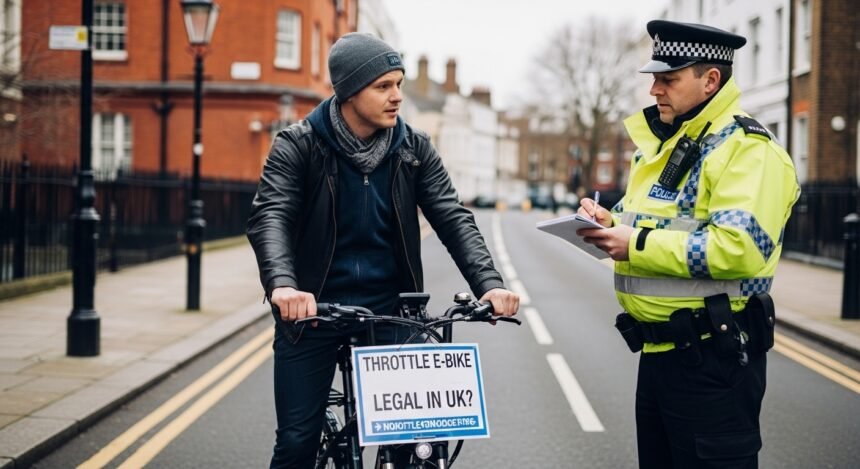Electric bikes have transformed commuting and leisure riding by offering an eco-friendly, efficient, and enjoyable mode of transport. However, one of the most debated topics among riders and potential buyers in the UK is the legality of throttle-operated electric bikes. While these bikes are widely available, their classification under UK law raises questions about where and how they can be used. Understanding the regulations surrounding throttle-assisted models is crucial before making a purchase or taking one on public roads.
The Legal Framework for Electric Bikes in the UK
Electric bikes in the UK are regulated under the Electrically Assisted Pedal Cycles (EAPC) framework. This means that for a bike to be considered road-legal, it must meet certain conditions. These include:
- The motor must not exceed 250 watts of continuous power.
- The motor should only assist while the rider is pedaling.
- The bike must not exceed 15.5 mph (25 km/h) when assisted by the motor.
When these criteria are met, the bike is treated the same as a conventional bicycle. This allows it to be ridden on cycle lanes, roads, and public paths without requiring insurance, tax, or a license. However, throttle electric bikes occupy a grey area within this legislation, creating challenges for riders who prefer throttle-only control.
What Defines a Throttle Electric Bike?
A throttle electric bike is designed to operate without continuous pedaling. Instead, the rider can twist or press the throttle to engage the motor, similar to a scooter. This makes riding easier in situations where pedaling may not be practical, such as steep hills or when a rider needs a quick boost of power. Models like the i scooter e bike have gained popularity for their convenience and flexibility. However, the presence of a throttle changes how the bike is classified under UK law, and this directly affects its legal use on public roads.
Why Throttle Electric Bikes Face Restrictions
The main reason throttle e-bikes face restrictions is their similarity to mopeds. Because the motor can propel the bike without pedaling, they are viewed as closer to motor vehicles than bicycles. This distinction means that, under current rules, throttle electric bikes may require type approval to be used legally. Once categorized as mopeds, riders would need a license, registration, insurance, and to wear a helmet when using them on public roads. These additional requirements make throttle e-bikes less appealing for everyday commuters who want the simplicity of a standard e-bike.
Exceptions and Recent Updates in UK Regulations
While traditional throttle e-bikes are restricted, some exceptions allow limited throttle functionality. For example, UK law permits throttles that assist up to 6 km/h (around 3.7 mph) without pedaling. This feature is often included as a “walk assist” function to help riders maneuver their bikes when walking alongside them. There have also been discussions and pilot programs exploring whether throttle electric bikes should be granted broader approval. As the popularity of e-bikes continues to grow, some industry experts believe that regulations may evolve to accommodate a wider range of models, including throttle-based designs like the i-scooter e-bike.
Where Throttle Electric Bikes Can Legally Be Used
Although throttle e-bikes face restrictions on public roads, they are not entirely prohibited. Riders can still use them on private land with the landowner’s permission. This makes them suitable for recreational use, such as on private estates, parks, or off-road trails where motor vehicle laws do not apply. For urban commuting, however, relying on a throttle e-bike without proper type approval could lead to fines, confiscation, or legal complications. Riders need to distinguish between private and public spaces to avoid potential issues.
The Impact on Riders and the Market
The restrictions on throttle electric bikes influence both consumer behavior and manufacturer strategies. Many buyers are drawn to the simplicity and ease of throttle use, but hesitate due to legal uncertainties. This has led some brands to design hybrid models that comply with EAPC regulations while offering throttle-like features under limited conditions. For instance, the i scooter e bike appeals to those seeking a balance between pedal assistance and throttle convenience. These innovations highlight how manufacturers adapt to market demand while staying within regulatory frameworks.
Comparing Throttle and Pedal-Assist Electric Bikes
Understanding the differences between throttle and pedal-assist systems helps riders make informed choices. Pedal-assist bikes fully comply with UK law, offering assistance only when pedaling and ensuring unrestricted access to cycle lanes and roads. They encourage physical activity while still making commuting easier. Throttle bikes, on the other hand, prioritize convenience, reducing the need for pedaling. While they may be more comfortable for some riders, especially those with physical limitations, the legal restrictions mean they are less practical for widespread road use in the UK. When deciding between the two, potential buyers must weigh legality against convenience, with many finding that models like the i scooter e bike offer a versatile middle ground.
The Future of Throttle Electric Bikes in the UK
As urban areas look for sustainable and accessible transport solutions, the role of electric bikes is expected to expand. It is possible that UK legislation will evolve to reflect changing attitudes toward throttle e-bikes. Industry lobbying, technological advancements, and the growing need for eco-friendly transport may all influence future policies. If regulations are updated, throttle bikes could become more widely accepted, offering greater choice for riders. Until then, compliance with current rules remains essential for avoiding legal issues. For now, pedal-assist systems dominate the market, while throttle-based designs remain an option for private use or specialized circumstances.
Conclusion
Throttle electric bikes present both opportunities and challenges for riders in the UK. While their convenience makes them attractive, current legislation places significant restrictions on their road use. By understanding the regulations, riders can avoid costly mistakes and make informed decisions about the type of e-bike that best fits their needs. For many, compliant pedal-assist models remain the safest choice for everyday commuting. Still, the popularity of throttle designs like the i scooter e bike suggests that demand will continue to influence future policy. As the market grows, the conversation around their legality is far from over.







